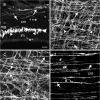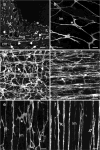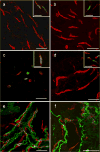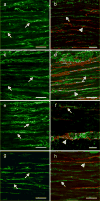Interstitial cells in the primate gastrointestinal tract
- PMID: 22864981
- PMCID: PMC4806557
- DOI: 10.1007/s00441-012-1468-7
Interstitial cells in the primate gastrointestinal tract
Abstract
Kit immunohistochemistry and confocal reconstructions have provided detailed 3-dimensional images of ICC networks throughout the gastrointestinal (GI) tract. Morphological criteria have been used to establish that different classes of ICC exist within the GI tract and physiological studies have shown that these classes have distinct physiological roles in GI motility. Structural studies have focused predominately on rodent models and less information is available on whether similar classes of ICC exist within the GI tracts of humans or non-human primates. Using Kit immunohistochemistry and confocal imaging, we examined the 3-dimensional structure of ICC throughout the GI tract of cynomolgus monkeys. Whole or flat mounts and cryostat sections were used to examine ICC networks in the lower esophageal sphincter (LES), stomach, small intestine and colon. Anti-histamine antibodies were used to distinguish ICC from mast cells in the lamina propria. Kit labeling identified complex networks of ICC populations throughout the non-human primate GI tract that have structural characteristics similar to that described for ICC populations in rodent models. ICC-MY formed anastomosing networks in the myenteric plexus region. ICC-IM were interposed between smooth muscle cells in the stomach and colon and were concentrated within the deep muscular plexus (ICC-DMP) of the intestine. ICC-SEP were found in septal regions of the antrum that separated circular muscle bundles. Spindle-shaped histamine(+) mast cells were found in the lamina propria throughout the GI tract. Since similar sub-populations of ICC exist within the GI tract of primates and rodents and the use of rodents to study the functional roles of different classes of ICC is warranted.
Figures







Similar articles
-
Relationship between enteric neurons and interstitial cells in the primate gastrointestinal tract.Neurogastroenterol Motil. 2012 Sep;24(9):e437-49. doi: 10.1111/j.1365-2982.2012.01975.x. Epub 2012 Jul 16. Neurogastroenterol Motil. 2012. PMID: 22805588 Free PMC article.
-
Interstitial cells of Cajal in the guinea-pig gastrointestinal tract as revealed by c-Kit immunohistochemistry.Cell Tissue Res. 1997 Oct;290(1):11-20. doi: 10.1007/s004410050902. Cell Tissue Res. 1997. PMID: 9377631
-
Interstitial cells of Cajal in the cynomolgus monkey rectoanal region and their relationship to sympathetic and nitrergic nerves.Am J Physiol Gastrointest Liver Physiol. 2010 May;298(5):G643-56. doi: 10.1152/ajpgi.00260.2009. Epub 2010 Feb 11. Am J Physiol Gastrointest Liver Physiol. 2010. PMID: 20150245 Free PMC article.
-
Structure and organization of interstitial cells of Cajal in the gastrointestinal tract.J Physiol. 2006 Nov 1;576(Pt 3):653-8. doi: 10.1113/jphysiol.2006.116624. Epub 2006 Aug 17. J Physiol. 2006. PMID: 16916909 Free PMC article. Review.
-
Understanding the Biology of Human Interstitial Cells of Cajal in Gastrointestinal Motility.Int J Mol Sci. 2020 Jun 25;21(12):4540. doi: 10.3390/ijms21124540. Int J Mol Sci. 2020. PMID: 32630607 Free PMC article. Review.
Cited by
-
The cells and conductance mediating cholinergic neurotransmission in the murine proximal stomach.J Physiol. 2018 May 1;596(9):1549-1574. doi: 10.1113/JP275478. Epub 2018 Mar 23. J Physiol. 2018. PMID: 29430647 Free PMC article.
-
Insights on gastrointestinal motility through the use of optogenetic sensors and actuators.J Physiol. 2022 Jul;600(13):3031-3052. doi: 10.1113/JP281930. Epub 2022 Jun 14. J Physiol. 2022. PMID: 35596741 Free PMC article. Review.
-
Excitatory Neuronal Responses of Ca2+ Transients in Interstitial Cells of Cajal in the Small Intestine.eNeuro. 2018 Apr 6;5(2):ENEURO.0080-18.2018. doi: 10.1523/ENEURO.0080-18.2018. eCollection 2018 Mar-Apr. eNeuro. 2018. PMID: 29632869 Free PMC article.
-
Excitatory cholinergic responses in mouse colon intramuscular interstitial cells of Cajal are due to enhanced Ca2+ release via M3 receptor activation.FASEB J. 2020 Aug;34(8):10073-10095. doi: 10.1096/fj.202000672R. Epub 2020 Jun 15. FASEB J. 2020. PMID: 32539213 Free PMC article.
-
Differential sensitivity of gastric and small intestinal muscles to inducible knockdown of anoctamin 1 and the effects on gastrointestinal motility.J Physiol. 2019 May;597(9):2337-2360. doi: 10.1113/JP277335. Epub 2019 Mar 28. J Physiol. 2019. PMID: 30843201 Free PMC article.
References
-
- Albertí E, Mikkelsen HB, Wang XY, Díaz M, Larsen JO, Huizinga JD, Jiménez M. Pacemaker activity and inhibitory neurotransmission in the colon of Ws/Ws mutant rats. Am J Physiol Gastrointest Liver Physiol. 2007;292:G1499–1510. - PubMed
-
- Aranishi H, Kunisawa Y, Komuro T. Characterization of interstitial cells of Cajal in the subserosal layer of the guinea-pig colon. Cell Tissue Res. 2009;335:323–329. - PubMed
-
- Burns AJ, Herbert TM, Ward SM, Sanders KM. Interstitial cells of Cajal in the guinea-pig gastrointestinal tract as revealed by c-Kit immunohistochemistry. Cell Tissue Res. 1997;290:11–20. - PubMed
Publication types
MeSH terms
Grants and funding
LinkOut - more resources
Full Text Sources

